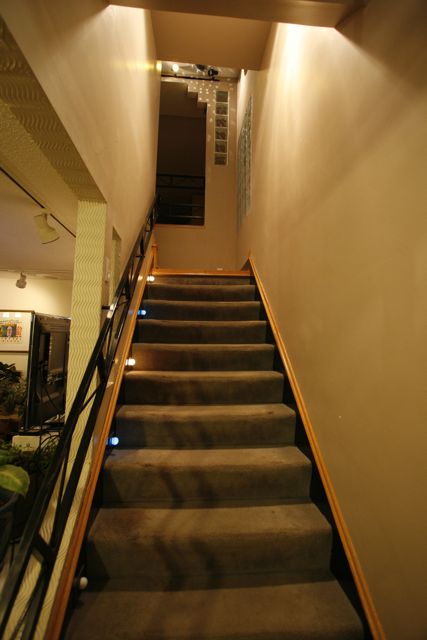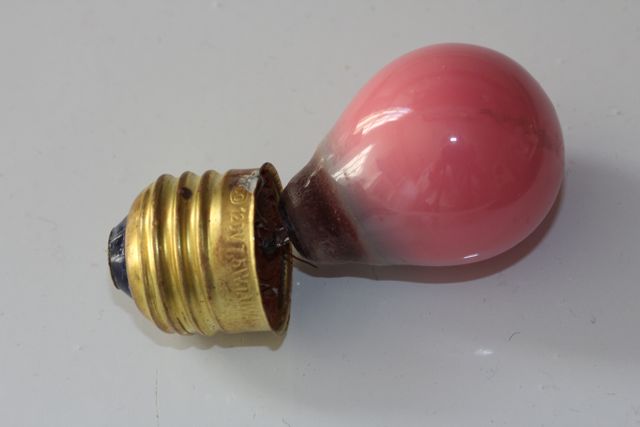One of the quirky features of This Odd House are the “runway lights” that accent the stairway to the second floor. They are on a dimmer switch (of course) and are fun to light up when company comes over (“who would do this?” is a common reaction). I happen to like them for their whimsical style and I intend to retain them.
But over the months of construction workers lugging stuff up and down the stairs, and the multiple movings of possessions by both amateurs and professionals, the vulnerable lights have suffered casualties. As the accidents occurred, replacements were installed, courtesy of a supply of bulbs left by the former owners.
But now that supply has run out! I thought it should be easy to simply go to a large light bulb supplier like Home Depot and buy more. It turns out that the little colored bulbs are not common and Home Depot, extensive as their lighting aisle is, does not carry them.
Instead, I have had to conduct an extensive internet search. Along the way I have learned far more about light bulbs than I ever expected to know, and I am now sharing that knowledge.
How would you go about finding a specialty light bulb? There are thousands of them and it took me a while to find the search keys for my stairway lights. The obvious ones include the technology (incandescent, not fluorescent or LED), the voltage, and the wattage, but that only narrows it down to thousands. Think of all the candelabras, night lights, make-up mirror lights, instrumentation lamps, accent lamps and movie marquees that you have ever encountered and you begin to see the wide world of lighting devices.
In my case, the key to finding it was the base. Small as they are, the runway lights screw into a standard light bulb fixture, what is eponymously called an “Edison socket” (aka Edison screw). It turns out there are several variations of the Edison socket, but the one we all know and love is the E26, which specifies a diameter of 26 millimeters.
The online bulb suppliers (Dons bulbs, for example), have search engines tuned for finding light bulbs. The main keys for finding a light bulb include the socket type and a code for the shape of the glass. Bulbs come in all shapes and sizes ; their shapes are encoded by a letter, such as “G” for globe, “T” for tube, “F” for flame. It may not be surprising that the familiar incandescent light bulb has the nondescript shape code of “A”, followed by a size code of 21, the number of eighth-inches across its diameter. So the standard U.S. light bulb mixes metric and English units: E26-A21.
I thought that my bulb was a “G” (globe), but after finding very few candidates, I discovered that it more likely is an “S” (straight sides), with a diameter of 11/8 inches. Unfortunately it is rare enough that many bulb suppliers do not carry it, or they have a small inventory and can charge $20 each for them.
I had to do some further searching for vendors, but now that I knew what I needed (120V 7.5W E26 S11), I could search for suppliers that had reasonable prices. I found one that offered them for about a dollar each. I ordered a dozen in various colors.
My stairway now has a full set of runway lights. A quirky feature, I know, but one that makes This Odd House what it is.



What would you do without the Internet?
The internet has transformed how we live our day to day lives, and how we design and plan things. I can’t imagine how hard it would be to accomplish some of these renovation tasks without it. I would be even MORE dependent on the experience of my subcontractors to know what they are doing. But because I can rapidly gain a little knowledge by typing “how to …” into a Google search box, I can augment and direct the construction forces, which are optimizing their return on time and costs, to meet MY interests and goals at the same time (plus, I get to learn cool stuff I would never have encountered!)
Idea:
http://www.superbrightleds.com/moreinfo/g-series-large/e27-36-led-globe-bulb/438/
http://www.superbrightleds.com/moreinfo/led-globe/2-watt-g11-globe-bulb-360-degree/440/
Yes, I looked up some LED replacement candidates, but they were $20 each (your links are more reasonable), so I decided to get the incandescent replacements, $20 for all of them. When they eventually burn out, the pricing will probably reverse!
Be sure to note the “DO DIMMER” note. Bad things might happen if you leave the dimmer in circuit. Maybe their more expensive cousins are dimmer ready.
Pingback: Stairway Lighting | This Odd House